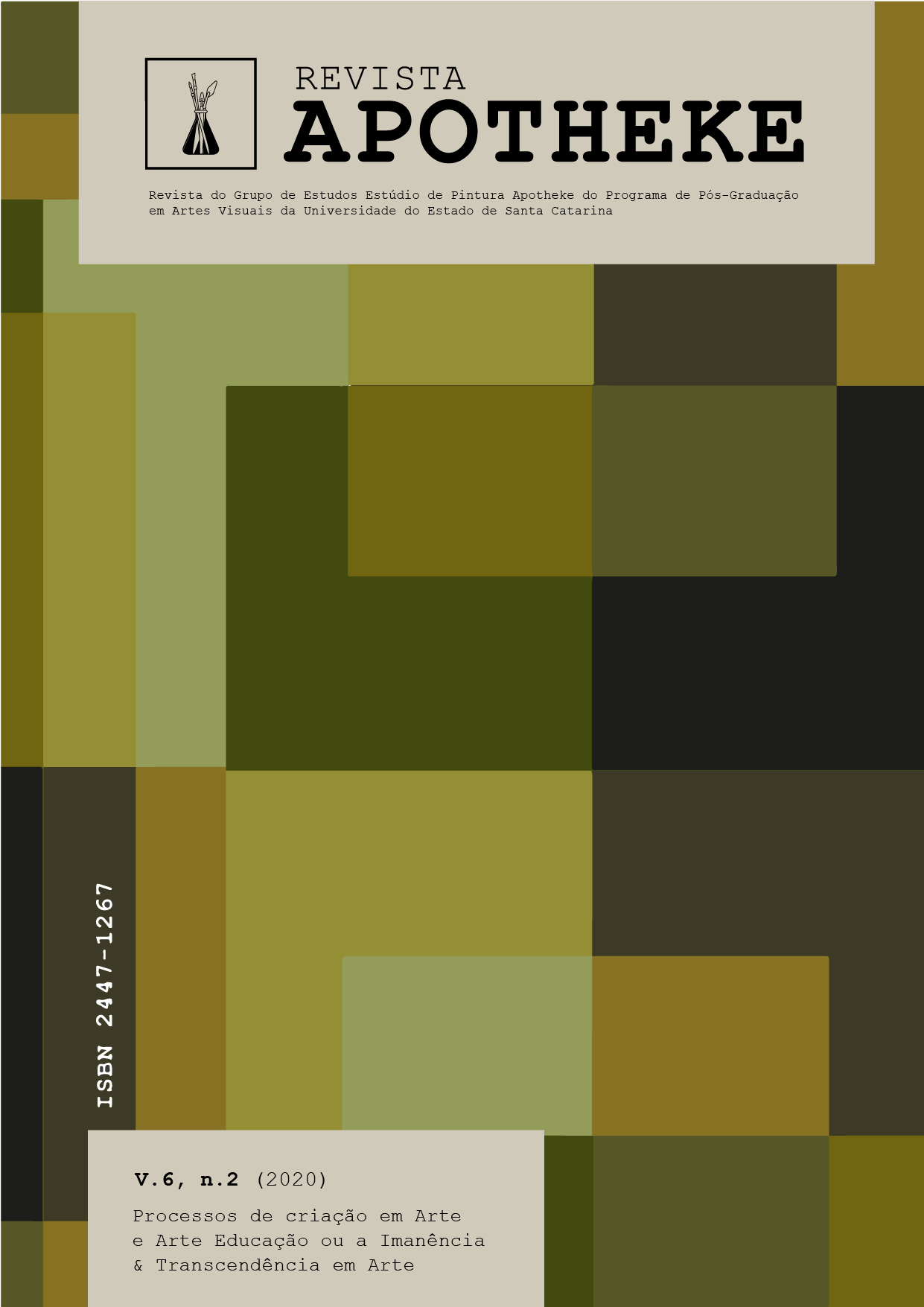Creation: discovering a hybrid path
DOI:
https://doi.org/10.5965/24471267622020100Keywords:
creation process, collective creation , visual artsAbstract
The research was developed from the use of the body through playful experiences in dialogue with the plastic production of the proposing artist, integrating a personal poetics and a pedagogical experience in Visual Arts. The works produced during this process caused a concern that instigated the research on: artistic creation, body as a support, aesthetic experience, exploration of materials and collective production. In the pedagogical line, the intention was to create strategies that led participants to explore the universe of art, expanding their artistic knowledge through the P.E.R.A Method, Yoshiura (1982). In the artistic line there was the search for a poetic singularity that, in a very subtle way, already brought the union of techniques and supports, configuring itself as an Interformative Hybridization, Valente (2008). This process resulted in the Desplante and Azuis series.
Downloads
References
BARBOSA, Ana Mae. Inquietações no ensino da arte. São Paulo: Cortez, 2002.
BARTHES, Roland. A câmara Clara: nota sobre a fotografia. Trad. Júlio Castañon Guimarães. Rio de Janeiro: Nova Fronteira, 2011.
DERDYK, Edith. O desenho da figura humana. São Paulo: Scipione, 1990.
DEWEY, John. Arte como experiência. Sã Paulo: Abril Cultural, 1974.
DOMINGUES, Diana. A Arte do séc. XXI: a humanização das tecnologias. São Paulo: UNESP, 1997.
FLUSSER. Filosofia da caixa preta – ensaios para uma futura filosofia da fotografia. Rio de Janeiro: Sinergia Relume Dumará, 2009.
GARCIA, Wilton (org). Corpo e Subjetividade: estudos contemporâneos. São Paulo: Factash Editora, 2006.
GERMANO, Nardo. Auto-retrato coletivo: Poéticas de Abertura ao Espectador na [des] Construção de uma Identidade Coletiva. Dissertação de Mestrado em Artes Visuais – Escola de Comunicações e Artes - ECA/USP, São Paulo, 2007.
HALL, Stuart. A Identidade Cultural na Pós-Modernidade. São Paulo: DP&A Editora, 2005.
JEUDY, Henri – Pierre. O corpo como objeto da Arte. Trad. Tereza
Lourenço. São Paulo: Estação Liberdade, 2002.
MATESCO, Viviane. Corpo: imagem e representação. Rio de Janeiro: Jorge Zahar, 2009.
PAREYSON, Luigi. Os problemas da estética. Tradução de Maria Helena Nery Garcez, São Paulo: Martins Fontes,1997.
______________. Estética – Teoria da Formatividade. Tradução de Ephraim Ferreira Alves. Petrópolis: ed. Vozes, 1993.
PIRES, Beatriz Ferreira. O corpo como suporte da Arte. São Paulo: Ed. SENAC, 2005.
PLAZA, Júlio e Mônica Tavares. Processos criativos com os meios eletrônicos: Poéticas digitais. São Paulo: Hucitec, 1998.
SALLES, Cecília Almeida. Gesto inacabado: processo de criação artística. São Paulo: Annablume, 1998.
_________________. Redes de criação. Vinhedo: Horizonte, 2006.
SANTAELA, Lucia. Corpo e Comunicação – sintoma da cultura. São Paulo: Paulus, 2004.
SHUSTERMAN, Richard. Vivendo a Arte: o pensamento pragmatista e a estética popular. São Paulo: Editora 34, 1998.
VALENTE, Agnus. Útero portanto Cosmos: Hibridações de Meios, Sistemas e Poéticas de um Sky-Art Interativo. 2008. Tese de Doutorado em Artes Visuais. São Paulo: Escola de Comunicações e Artes -ECA/USP, 2008.
YOSHIURA, Eunice Ferreira Vaz. Desenvolvimento criativo: uma proposta metodológica e sua verificação. Dissertação de mestrado. São Paulo: Escola de Comunicação e Artes -ECA/USP, 1982.
_____________. Constituição do Sujeito receptivo na comunicação – a experiência estética como caminho . ANNABLUME, São Paulo, 2009.
Downloads
Published
How to Cite
Issue
Section
License
Copyright (c) 2020 REVISTA APOTHEKE

This work is licensed under a Creative Commons Attribution-NonCommercial 4.0 International License.
Copyright and Licensing Policy
Authors of works submitted to Revista APOTHEKE authorize their publication in both print and digital formats exclusively for academic purposes. Reproduction is permitted, provided that the source is properly cited. Authors confirm the originality, authorship, and unpublished status of their manuscripts.
Articles published by the journal are freely available and intended for academic and non-commercial use only. All copyrights are transferred to the journal. The content of signed articles reflects the views of their respective authors and not the official position of Revista Apotheke. The author(s) agree to always cite the following reference when republishing or referring to the content originally published in Revista Apotheke:
“This article was originally published by Revista Apotheke in volume (insert volume), number (insert number), year (insert year), and is available at: http://www.revistas.udesc.br/index.php/APOTHEKE/index”
It is the sole responsibility of the authors to obtain written permission for the use of any material protected by copyright law included in their articles. Revista Apotheke is not responsible for copyright infringements committed by contributors.
Authors retain copyright and grant the journal the right of first publication, with the work licensed under a Creative Commons Attribution-NonCommercial License (CC BY-NC):
-
Attribution (BY): Licensees are allowed to copy, distribute, display, perform, and create derivative works, provided that proper credit is given to the author or licensor, in the manner specified.
-
NonCommercial (NC): Licensees may use the material only for non-commercial purposes.
After publication, authors retain the rights to their work and may republish the text.



